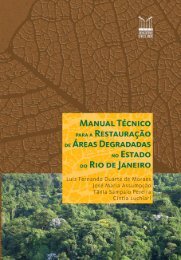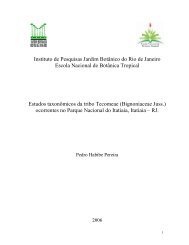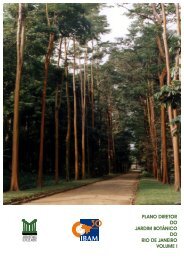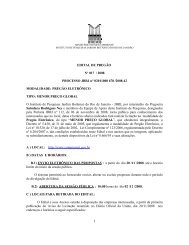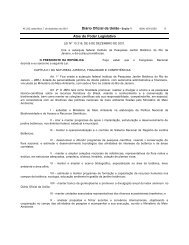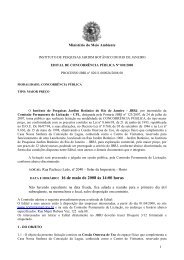anatomia do lenho e dendrocronologia de lianas da famÃlia ...
anatomia do lenho e dendrocronologia de lianas da famÃlia ...
anatomia do lenho e dendrocronologia de lianas da famÃlia ...
Create successful ePaper yourself
Turn your PDF publications into a flip-book with our unique Google optimized e-Paper software.
53<br />
In the last <strong>de</strong>ca<strong>de</strong>s the knowledge about growth rings in tropics improved, but its occurrence<br />
remains with low scientific acceptance (Worbes, 2002). This laid on concept that tropical<br />
region lack marked seasons, which produce distinct growth rings. But the contrary had been<br />
<strong>de</strong>monstrated in many studies, in which approximately half of species from these regions had<br />
distinct growth rings. The same was realized in this study. Alves & Angyalossy-Alfonso<br />
(2000) observed ecological trends in some Brazilian tree species, which <strong>de</strong>tect that 48 % of<br />
the studied species have growth rings correlated positively with mild and medium<br />
mesothermic climates and negatively related to super-humid environments. In this study 136<br />
species of Leguminosae family were sampled and 71 species presented distinct growth rings.<br />
Among them, four species are of the genus Pipta<strong>de</strong>nia and five of genus Dalbergia, including<br />
D. frutescens. The interactive key for commercial timbers, from Delta Databases (Richter &<br />
Dallwitz, 2000), indicate eleven species with distinct growth ring of 24 Leguminosae species<br />
from tropical South America. Seven with marginal parenchyma and among them two have<br />
semi-ring-porosity. Dalbergia <strong>de</strong>cipularis Matt. & Rizz. and Pipta<strong>de</strong>nia macrocarpa Benth.<br />
are examples of tree species with distinct growth ring from tropical South America. Roig et<br />
al. (2005) report that 42 % of the studied Leguminosae species in Yucatan Peninsula had<br />
visible rings. These previous studies and the present study show that growth rings in<br />
Leguminosae species, trees and <strong>lianas</strong>, from tropical region is a frequent feature.<br />
Growth rings in <strong>lianas</strong> were <strong>de</strong>tected in other studies. Gasson & Dobbins (1991) report<br />
distinct growth rings in Bignoniaceae family, genus Capsis from tribe Tecomeae, in genus<br />
Schlegelia from tribe Schlegelieae and in nine genera from tribe Bignonieae. Among diverse<br />
plant habits from Europe, Baas & Schweingruber (1987) observed that climbers show porousring,<br />
semi-ring-porous. But they <strong>do</strong> not sampled Leguminosae species and the samples<br />
analysed were from temperate climate. In other study within <strong>lianas</strong> in Venezuela, it was<br />
observed growth rings in Anomospermun schomburgkii Miers (Menispermaceae) and<br />
Strycnos brachistantha Standley (Loganiaceae), marked by marginal parenchyma (Araque et<br />
al., 2000). These two species showed diffuse porosity. Semi-ring porous and marginal<br />
parenchyma were important features observed in <strong>lianas</strong> analysed on this study, because they<br />
are present in all species with distinct growth ring. The growth rings are ma<strong>de</strong> of variation in<br />
cambium activity and its products, and each ring may represent a period of one year (Fahn,<br />
1982). A cambium activity study <strong>de</strong>tected in four <strong>lianas</strong> from a Mexican tropical rainforest<br />
that cambium is active along all year. Although, three species showed strong cambial<br />
seasonality, differing by number of cambial layers, positively associated with rainfall. Two


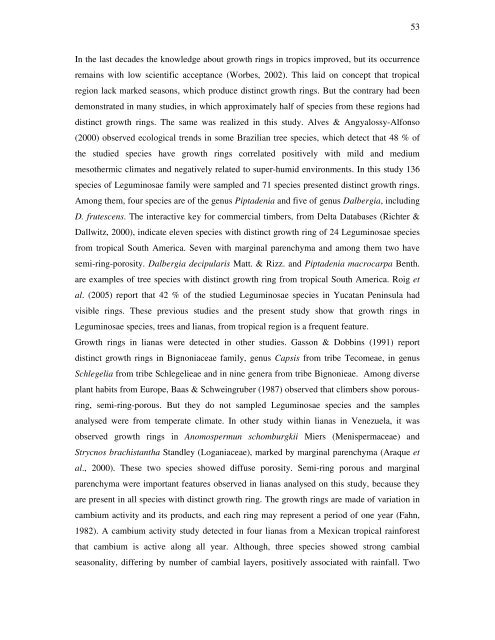
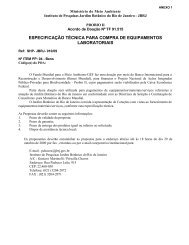
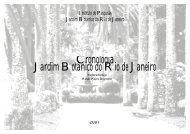
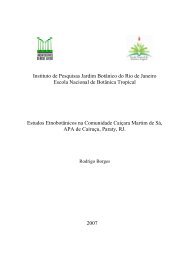
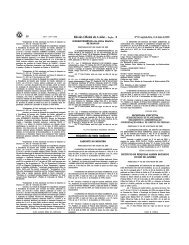
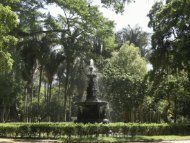
![Memorando nº [Número do memorando/DAMF-RJ/Nome da Unidade]](https://img.yumpu.com/43163661/1/184x260/memorando-na-namero-do-memorando-damf-rj-nome-da-unidade.jpg?quality=85)
